- Joined
- Dec 11, 2018
- Messages
- 1,185
- Trophies
- 0
In 2017, a telescope in Hawaii detected our first celestial visitor from another solar system — a big deal, since we haven’t quite figured out how to visit them ourselves yet. ‘Oumuamua, the cigar-shaped interstellar object (ISO) whose name roughly translates to “first distant messenger” in Hawaiian, will certainly not be the last visitor to pass through. If the story of our universe is written in the stars, even a tiny fragment traveling a long way for a short visit provides a tremendous opportunity for scientific discovery. But in order to get close enough to read the next piece of the story that wanders onto our doorstep, we will have to catch it first.
To closely observe an ISO hurtling through space, time is of the essence. Richard Linares, an assistant professor in the Department of Aeronautics and Astronautics (AeroAstro) at MIT, developed a concept for a “dynamic orbital slingshot for rendezvous with interstellar objects.” He outlined his idea in a research proposal that was recently selected as a Phase 1 study in the NASA Innovative Advanced Concepts (NIAC) Program, which “funds innovative aerospace concepts that could enable and transform future missions.”
To eliminate these barriers, Linares instead proposes using statites, or “static satellites” enabled by a solar sail constructed with just the right mass-to-area ratio. A thin enough sail with a large enough surface area will have a low enough mass to use solar radiation pressure to cancel out the sun’s gravitational force no matter how far away it is, creating a propulsive force that allows the statite to hover in place indefinitely. Linares envisions deploying a constellation of statites to act as interstellar watchdogs along the edges of our solar system, lying in wait until roused by an ISO crossing our threshold.

Once detected, the solar sail then enables the statite to switch gears quickly and spring into action. Since the statite has a velocity of zero, it is already in position for efficient trajectory. Once released, the stored energy in the solar sail would leverage the gravitational pull of the sun to slingshot the statite in a freefall trajectory towards the ISO, allowing it to catch up. If the timing is right, the statite could tag the ISO with a CubeSat armed with onboard sensors to orbit the ISO over an extended period of time, gathering important scientific data.
“Studying an interstellar body close-up would revolutionize our understanding of planet formation and evolution,” says Weiss. “For the first time, we could obtain sensitive measurements of the bulk composition of other solar systems. We could also learn how quickly and how commonly objects transit between solar systems, which will tell us the feasibility of the interstellar transfer of life.”

To catch an interstellar visitor, use a solar-powered space slingshot
An MIT research proposal for rendezvous missions with interstellar objects has been selected for NASA Innovative Advanced Concepts Program. The project, which will deploy multiple statites, or static satellites, enabled by a solar sail, is led by Assistant Professor Richard Linares of MIT AeroAstro.